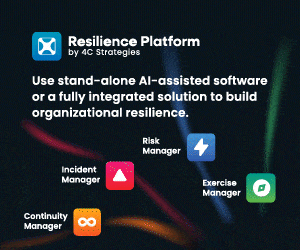How to debrief after a Business Continuity Exercise

Carrying out an exercise and then not conducting a debrief is a pointless waste of time and money. If you’re looking to practice teamwork, decision making and problem-solving, then you’d be better off spending your time going to an escape room. Identifying lessons and actions, recording and then implementing them is key to continually improving your business continuity response and, in turn, improving your organization’s resilience.
Although the process of debriefing takes place after the exercise, both the preparation before it and observation during are critical to a successful debrief and to learning the lessons of the exercise. For this article, I am going to concentrate on a hot debrief conducted after a 2-3hr Simulation Exercise (tabletop/desktop exercise) or a Simulation Exercise (SIMEX). Longer or more complex exercises may have a cold debrief some time after the exercise.
Pre-exercise
The following are activities that should take place pre-exercise to ensure a successful debrief:
- Agree on a purpose for your exercise. This is why you are carrying out the exercise. The reason for carrying out the exercise may determine the type of exercise and any elements of it. I don’t use ‘aims of the exercise’, as most people don’t know the difference between an aim and an objective.
- Write a list of 3-5 objectives for the exercise. These can vary from teamwork, decision making, understanding the organization's response to a scenario, checking strategies or validating a plan. Revising them during the debrief is a good check to see if they were achieved.
- Appoint at least two umpires per team, who will observe the team being exercised. You should have one person from the organization conducting the exercise and the other person from the organization being exercised. One umpire can look at the more general incident management, while the internal umpire can comment on the response by the organization. In a SIMEX, I believe that the Exercise Director should not be an umpire, as they are concentrating on running the exercise.
- Leave time for the debrief. Thirty minutes should be left at the end of a 3hr exercise to get the full value out of the debrief. I also try and leave a little time after the debrief for a more in-depth discussion with the umpires and role players for any additional exercise points. Also, this is a good opportunity to discuss the planning and execution of the exercise, and also to see if any other lessons can be learnt.
During the exercise
- Umpires should observe the actions of the team. They should take into account the purpose and objectives but should also have a framework of items to be looking at. I use the mnemonic ‘TITOPIC’ for the areas of the team’s performance they may want to comment on.
|
Letter |
Area |
Detailed areas |
|
T |
Team working and personnel |
This is looking at the team, the members of the team and how well they worked together. |
|
I |
Incident management skills |
How well did the team use the skills taught to them? Could they improve their use? |
|
T |
Training |
Were the team appropriately trained in their role or do they require further training? |
|
O |
Organizational issues |
Was the team’s structure and incident hierarchy appropriate for the organization? Were the roles and responsibilities of each of those taking part applicable? Did those responding follow their roles? |
|
P |
Plans and procedures |
Did the plans and procedures have the appropriate information within them and was anything missing? Did following them produce the desired outcomes and were they used during the exercise? |
|
I |
Infrastructure |
Did the equipment and resources available to the team meet their requirements? This could also include a comment on the physical space which the team were responding from. |
|
C |
Communications and reputation management |
How well did they communicate internally within the team, internally within the organization and externally with interested parties? |
The debrief
- I like for everyone to have the chance to speak during a debrief. Therefore, I normally ask the team to share ‘one learning point’ each, starting with the team leader. If there is time, I may extend it to one learning point plus an action they think could be carried out to improve the response. I then ask the role players, umpires and the Exercise Director for 2-3 of their points.
- In debriefs, I always ask participants to look to the future and consider how improvements can be made, rather than dwell on what actually happened during the exercise.
- Participants could be asked verbally about whether the exercise objectives were achieved or they could be asked in a feedback form.
- Written feedback forms can be good for capturing additional points that people might not be comfortable voicing during the oral feedback. I would always have oral feedback and then follow it up with a feedback sheet.
- On the feedback form, you may want to ask how participants ‘rate the exercise’. I think you have to consider the value of this. Exercises can be challenging and put people in uncomfortable positions. They may not enjoy the actual experience but that might be the purpose of the exercise. In my experience, especially if they are senior managers, they will tell you if they think the exercise was badly run!
- In the post-exercise report, you should write observations and recommendations, but not have more than fifteen of them. It is important that recommendations are reviewed and that they are allocated to someone with a date for their implementation.

